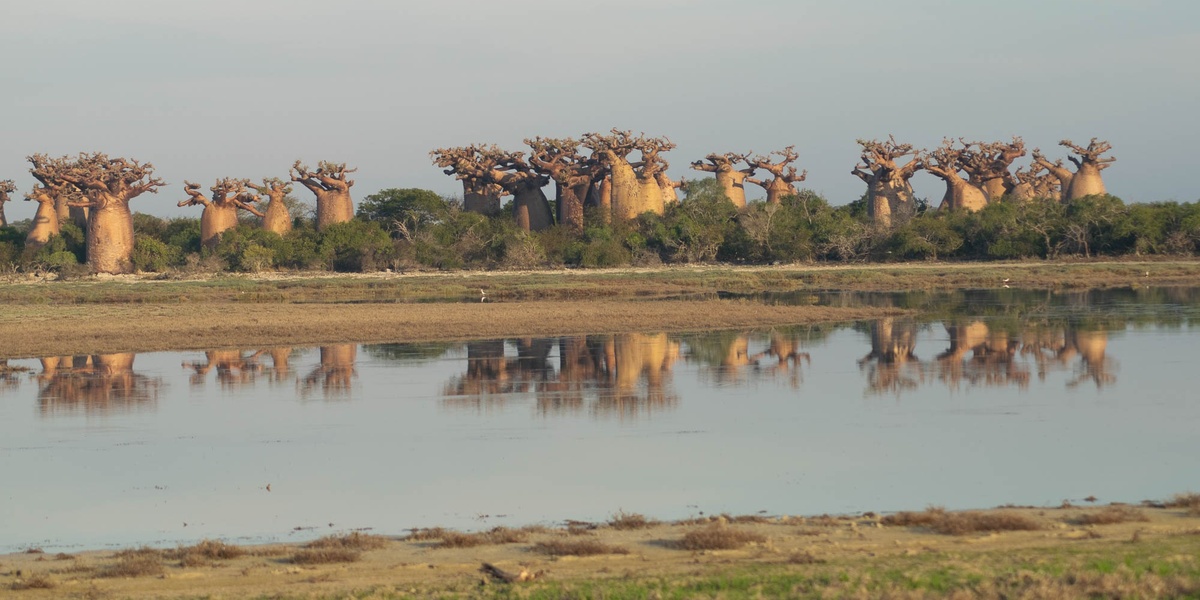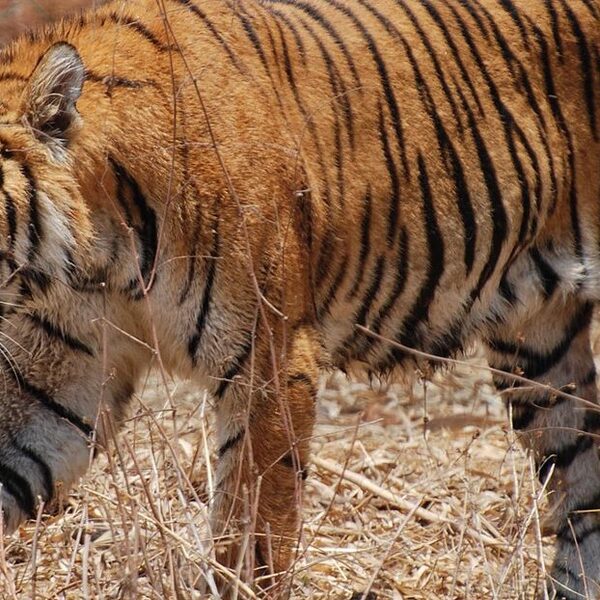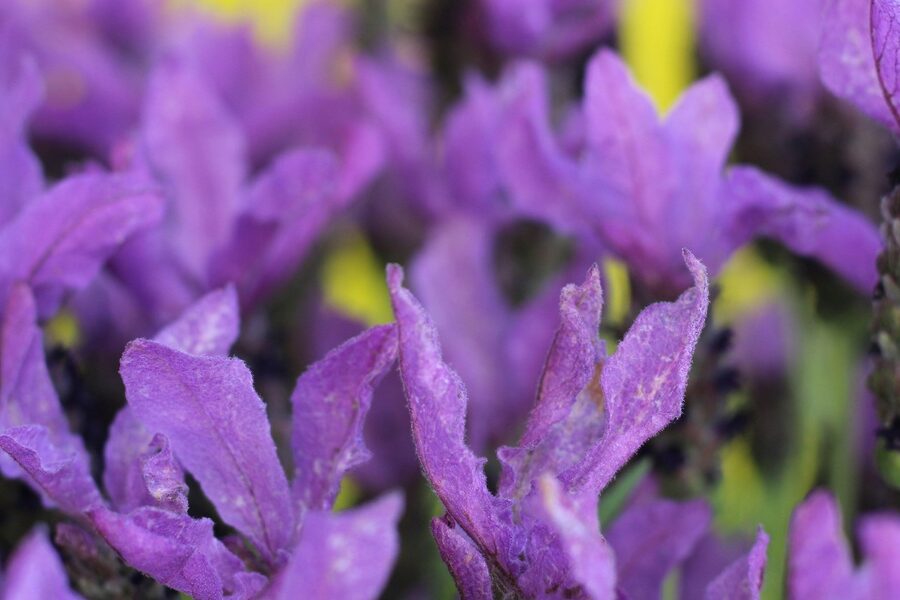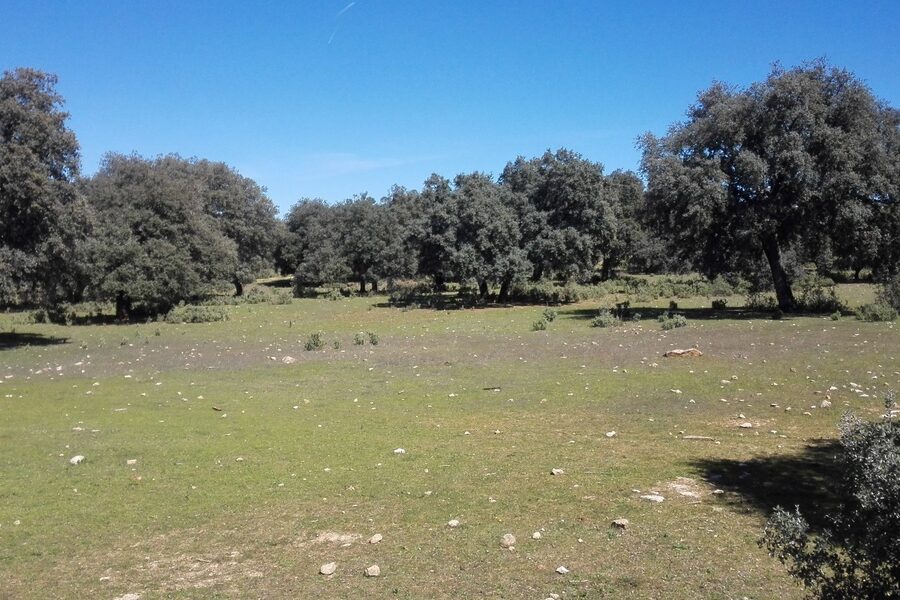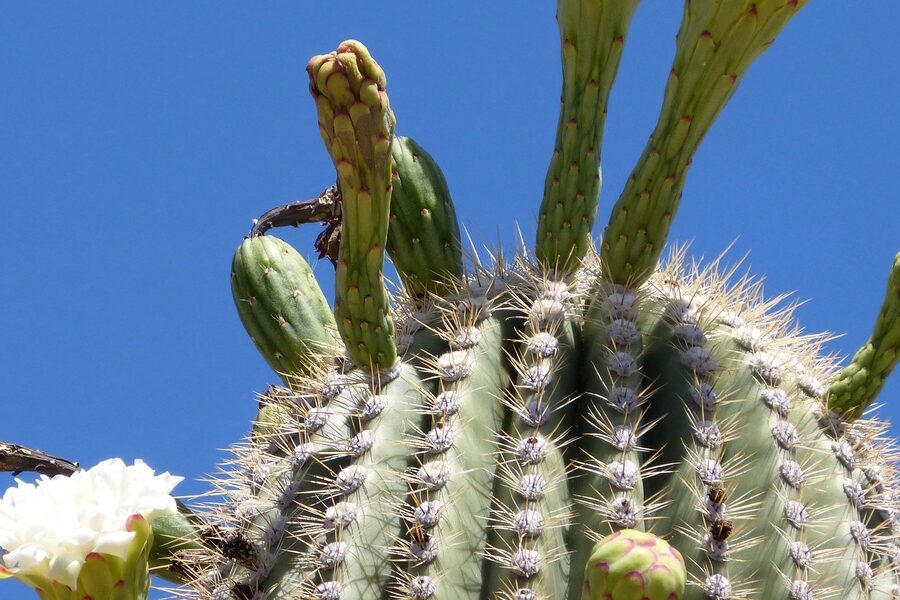Senegal’s mix of coastal, savanna and Sahelian zones supports a wide variety of trees that matter to local communities, wildlife and land use. Knowing which species occur where makes a big difference for planting, restoration and simple curiosity when you’re traveling or studying the region.
There are 93 Trees of Senegal, ranging from Acacia sieberiana to Winter Thorn. Data for each entry is organized with the columns Scientific name,Height (m),Where found so you can quickly see taxonomy, typical size and distribution — you’ll find it all below.
How can I use the columns to identify a tree in the field?
Start with the Scientific name to match photos or local guides, use Height (m) to check if the observed tree fits expected size, and consult Where found to narrow by habitat or region; combine those details with leaves, bark and fruit characters for reliable identification.
Does the list include both native and introduced species?
Yes — the list covers native, naturalized and commonly encountered introduced species; check the Where found notes and follow up with regional floras or herbarium records if you need confirmation about nativity or conservation status.
Trees of Senegal
| Common name | Scientific name | Height (m) | Where found |
|---|---|---|---|
| African Baobab | Adansonia digitata | 20 | Widespread in dry savannas and bushlands across the country. |
| Shea Tree | Vitellaria paradoxa | 15 | Sudanian savanna parklands, particularly in the south and east. |
| African Locust Bean | Parkia biglobosa | 18 | Sudanian savanna parklands, common throughout the country. |
| Tamarind | Tamarindus indica | 20 | Common in savannas and woodlands, often found near villages. |
| Gum Arabic Tree | Senegalia senegal | 6 | Common in the Sahelian zone, on dry sandy soils and in acacia savannas. |
| African Mahogany | Khaya senegalensis | 30 | Sudanian savannas and gallery forests, especially in southern and eastern Senegal. |
| Winter Thorn | Faidherbia albida | 25 | Riverbanks, floodplains, and agroforestry parklands across the Sahel and Sudanian zones. |
| Desert Date | Balanites aegyptiaca | 9 | Sahelian and Sudanian zones, thrives in arid and semi-arid sandy soils. |
| African Palmyra Palm | Borassus aethiopum | 25 | Sudanian savannas, common in gallery forests and along watercourses. |
| Kapok Tree | Ceiba pentandra | 40 | Humid forests of Casamance and along rivers in the Sudanian zone. |
| African Rosewood | Pterocarpus erinaceus | 15 | Sudanian woodlands and dry forests, often on rocky or lateritic soils. |
| Red-flowered Silk Cotton Tree | Bombax costatum | 20 | Dry, rocky savannas of the Sudanian zone. |
| Marula | Sclerocarya birrea | 15 | Sudanian savanna woodlands, particularly in the south-east. |
| Tallow Tree | Detarium senegalense | 30 | Sudanian woodlands and gallery forests, especially in southern Senegal. |
| Indian Jujube | Ziziphus mauritiana | 10 | Widespread in Sahelian and Sudanian zones, often found in cultivated parklands. |
| Egyptian Mimosa | Vachellia nilotica | 12 | Riverbanks, floodplains, and seasonally wet areas in Sahel and Sudanian zones. |
| Red Acacia | Vachellia seyal | 10 | Clay soils and seasonally flooded areas in the Sahelian zone. |
| Umbrella Thorn Acacia | Vachellia tortilis | 15 | Arid and semi-arid regions of the Sahel, on sandy and rocky soils. |
| African Ebony | Diospyros mespiliformis | 20 | Savannas and gallery forests, often found on termite mounds. |
| African Fan Palm | Hyphaene thebaica | 15 | Dry riverbeds and oases in the northern Sahelian zone. |
| Senegal Date Palm | Phoenix reclinata | 8 | Riverbanks, swamps, and coastal areas throughout the country. |
| Oil Palm | Elaeis guineensis | 20 | Humid coastal regions and the Casamance, in gallery forests and plantations. |
| Black Plum | Vitex doniana | 15 | Sudanian savanna and gallery forests, widespread in moister areas. |
| Fever Berry | Croton gratissimus | 7 | Dry, rocky hillsides in the Sudanian zone. |
| African Teak | Milicia excelsa | 40 | Moist forests and riverine areas, primarily in the Casamance. |
| African Olive | Olea europaea subsp. cuspidata | 10 | Found in specific highland or rocky areas in south-eastern Senegal. |
| Candlewood | Zanthoxylum zanthoxyloides | 9 | Coastal thickets and savanna woodlands, especially near the sea. |
| White Thorn | Vachellia hebeclada | 5 | Dry sandy soils in the Sahelian zone. |
| African Myrrh | Commiphora africana | 5 | Dry, rocky areas in the Sahel and Sudanian savannas. |
| Frankincense Tree | Boswellia dalzielii | 12 | Rocky hills and plateaus in the Sudanian zone of south-eastern Senegal. |
| Bushwillow | Combretum micranthum | 8 | Widespread in dry savannas and bushland, very common in the Sahel. |
| Velvet Tamarind | Dialium guineense | 25 | Gallery forests and savanna woodlands in the south, especially Casamance. |
| Sickle Bush | Dichrostachys cinerea | 6 | Dry savannas and disturbed areas throughout the country. |
| Quinine Tree | Rauvolfia vomitoria | 10 | Understory of gallery forests and humid secondary forests in Casamance. |
| Anogeissus | Anogeissus leiocarpa | 25 | Sudanian savannas and dry forests, often dominant in woodlands. |
| Wild Mango | Cordyla pinnata | 15 | Dry savannas and woodlands, particularly in the Sudanian zone. |
| Grey-haired Bushwillow | Combretum glutinosum | 10 | Very common in Sahelian and Sudanian savannas on sandy soils. |
| Cashew | Anacardium occidentale | 10 | Naturalized in coastal regions and the Casamance, often in sandy soils. |
| Scented-pod Acacia | Vachellia gerrardii | 12 | Wooded grasslands and savannas, often on heavier soils. |
| African Apple | Lannea microcarpa | 12 | Sudanian savanna parklands, often found on cultivated or fallow land. |
| Smoky-barked Acacia | Senegalia laeta | 7 | Dry, sandy, and rocky soils in the Sahelian zone. |
| Bitter Leaf | Vernonia amygdalina | 6 | Gallery forests and humid savanna areas, often near streams. |
| Red Ironwood | Lophira lanceolata | 15 | Sudanian savannas, especially those with high rainfall. |
| Neem | Azadirachta indica | 15 | Widely planted and naturalized throughout Senegal, especially in towns and villages. |
| Jocote | Spondias purpurea | 7 | Naturalized in Casamance and coastal areas, often cultivated. |
| Flamboyant Tree | Delonix regia | 12 | Widely planted as an ornamental and naturalized in towns across Senegal. |
| Mango | Mangifera indica | 25 | Widely cultivated and naturalized, especially in the Casamance and coastal regions. |
| Guava | Psidium guajava | 8 | Widely naturalized in humid areas, often near settlements. |
| African Breadfruit | Treculia africana | 20 | Moist forests of the Casamance region. |
| Fig Tree | Ficus thonningii | 18 | Widespread in savannas and forests, often as a strangler. |
| Sycomore Fig | Ficus sycomorus | 20 | Riverine areas and savannas with high groundwater. |
| Jagua | Genipa americana | 15 | Humid forests and riverbanks in the Casamance. |
| Sausage Tree | Kigelia africana | 15 | Riverbanks and floodplains in the Sudanian and Guinean zones. |
| Soapberry | Sapindus saponaria | 10 | Gallery forests and humid savannas. |
| Camel’s Foot | Piliostigma reticulatum | 8 | Common in Sudanian and Sahelian savannas, especially on degraded land. |
| African Birch | Combretum paniculatum | 9 | Forest margins and gallery forests in the south. |
| Wild Custard Apple | Annona senegalensis | 6 | Widespread in Sudanian savanna woodlands. |
| Monkey Orange | Strychnos spinosa | 7 | Savanna woodlands throughout the country. |
| Bush Mango | Irvingia gabonensis | 25 | Moist forests of the Casamance. |
| Senegal Lilac | Securidaca longipedunculata | 6 | Sudanian savannas, often on sandy soils. |
| Balsam Tree | Daniellia oliveri | 20 | Sudanian savanna woodlands. |
| Bastard Mahogany | Trichilia emetica | 15 | Riverine forests and coastal woodlands. |
| African Canarium | Canarium schweinfurthii | 35 | Moist forests of the Casamance. |
| Eucalyptus | Eucalyptus camaldulensis | 30 | Widely planted in plantations for firewood, poles, and windbreaks. |
| Acacia sieberiana | Vachellia sieberiana | 15 | Wooded grasslands and savannas, often near rivers. |
| Rhun Palm | Raphia sudanica | 8 | Swampy areas and stream banks in southern Senegal. |
| Water Berry | Syzygium guineense | 20 | Riverbanks, swamp forests, and moist savanna woodlands. |
| Cordia | Cordia africana | 12 | Sudanian savannas and highlands. |
| Corkwood | Hymenocardia acida | 7 | Sudanian savannas, especially on ironstone plateaus. |
| African Dragon’s Blood Tree | Dracaena arborea | 10 | Understory of humid coastal and gallery forests. |
| Gmelina | Gmelina arborea | 20 | Planted in forestry projects and naturalized in some humid areas. |
| White Stinkwood | Celtis africana | 18 | Gallery forests and upland areas in southern Senegal. |
| Red Stinkwood | Prunus africana | 20 | Found in relict montane forest patches in the southeast. |
| Terminalia | Terminalia macroptera | 18 | Sudanian savannas, particularly in seasonally waterlogged areas. |
| Cat’s Claw | Catunaregam spinosa | 6 | Savanna woodlands and thickets. |
| Buffalo Thorn | Ziziphus mucronata | 9 | Savannas and riverine thickets. |
| Leadwood | Combretum molle | 10 | Widespread in wooded savannas, often on hillsides. |
| Strychnine Tree | Strychnos nux-vomica | 12 | Potentially found in southern Senegal, though rare. |
| Wild Pear | Dombeya quinqueseta | 5 | Savanna woodlands. |
| Raisin Bush | Grewia mollis | 6 | Dry savannas and rocky outcrops. |
| False Mopane | Guibourtia coleosperma | 18 | Dry woodlands in the south-east, on sandy soils. |
| Poison-pod Albizia | Albizia versicolor | 15 | Wooded grasslands and savannas in the south. |
| Wild Gardenia | Gardenia ternifolia | 5 | Sudanian savannas, often on rocky soils. |
| African Star Apple | Chrysophyllum albidum | 25 | Moist semi-deciduous forests of the Casamance. |
| Leafflower Tree | Margaritaria discoidea | 15 | Gallery forests and secondary woodlands. |
| Bird Plum | Berchemia discolor | 12 | Savanna woodlands and riverine fringes. |
| Fishtail Acacia | Senegalia polyacantha | 15 | Savannas and old farmland, often near watercourses. |
| Paperbark Thorn | Vachellia woodii | 12 | Wooded grasslands and savannas. |
| African Dog Rose | Xylopia aethiopica | 20 | Gallery forests and moist woodlands in southern Senegal. |
| Jumping Seed Tree | Sapium ellipticum | 15 | Forest margins and secondary growth in humid zones. |
| Bush Cherry | Maerua angolensis | 9 | Dry savannas and bushland. |
| Crown Berry | Crossopteryx febrifuga | 10 | Sudanian savanna woodlands. |
| Fara | Ficus capreifolia | 7 | Along rivers and streams, forming thickets. |
Images and Descriptions

African Baobab
Iconic tree with a massive, swollen trunk and sparse, finger-like leaves. Its fruit, “monkey bread,” is edible and rich in vitamin C. The baobab is culturally significant, a source of food, fiber, and medicine.
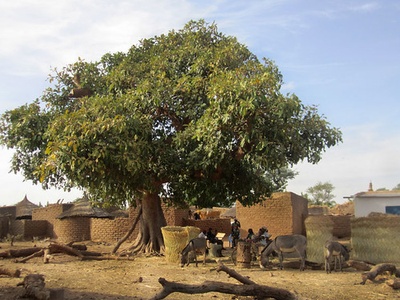
Shea Tree
A medium-sized tree known for its precious nuts, which are processed to make shea butter. This butter is a vital local food source and a globally important cosmetic ingredient. The tree is protected in many communities.
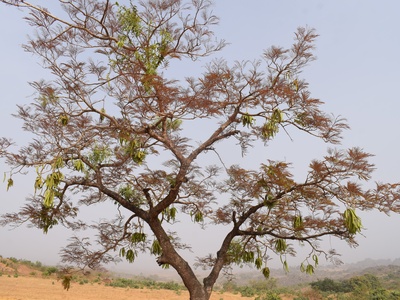
African Locust Bean
Recognizable by its spreading crown and long pods containing a sweet pulp. The fermented seeds, called ‘nététou’ or ‘soumbala’, are a popular and pungent food seasoning. The tree also improves soil fertility.

Tamarind
A large, long-lived tree with dense foliage and curved brown pods. The sour-sweet pulp from the pods is used in drinks, sauces, and traditional medicine. Its hard wood is used for furniture and tool handles.
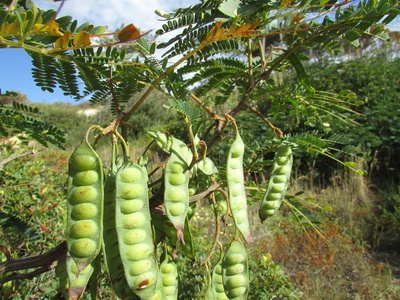
Gum Arabic Tree
A small, thorny tree famous for producing gum arabic, a key export. Its feathery leaves and sharp thorns are typical of acacias. The gum is harvested from cuts in the bark for use as a food stabilizer.
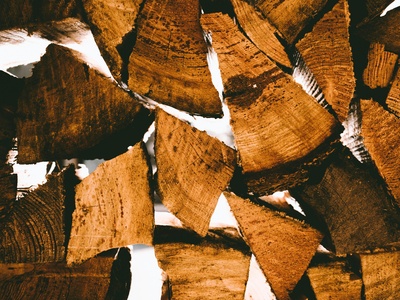
African Mahogany
A large, valuable timber tree with a straight trunk and dark, fissured bark. Its hard, reddish-brown wood is highly prized for furniture. The bitter bark is also widely used in traditional medicine.
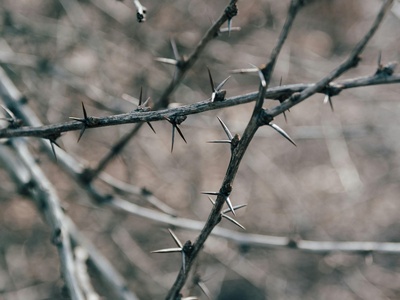
Winter Thorn
A large acacia-like tree unique for being dormant during the rainy season. This “reverse phenology” makes it ideal for intercropping, as it doesn’t compete with crops for light. Its pods provide vital dry-season fodder for livestock.

Desert Date
A spiny, resilient tree that stays green year-round. It produces a bitter-sweet, date-like fruit. The oil-rich seeds are used to make soap and oil, while the hard wood is used for charcoal and tools.
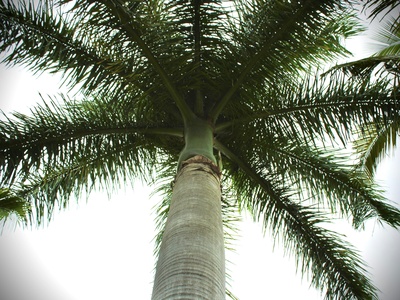
African Palmyra Palm
A tall, majestic fan palm with a straight, grey trunk, often swollen in the middle. The fruit is edible, and the sap is tapped to make palm wine. The strong, termite-resistant wood is used for construction.
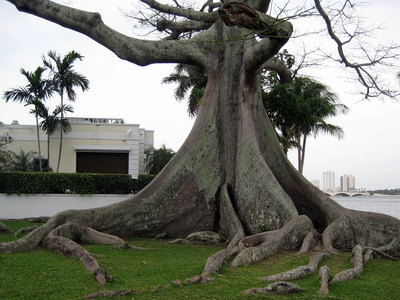
Kapok Tree
A massive tree with a buttressed trunk often covered in conical spines. Its pods contain a silky, cotton-like fiber (kapok) used for stuffing pillows and mattresses. It is a fast-growing pioneer species.

African Rosewood
A medium-sized tree with a twisted trunk and rough, dark bark that exudes a red sap. Its high-quality, durable timber is used for furniture, flooring, and musical instruments. It is a threatened species due to over-harvesting.

Red-flowered Silk Cotton Tree
A striking deciduous tree with a thorny trunk that produces large, brilliant red flowers before the leaves appear. The pods yield a cotton-like fiber. Its wood is soft and used for making canoes and domestic utensils.

Marula
A medium-sized tree with a spreading crown, known for its pale yellow, vitamin C-rich fruit. The fruit is eaten fresh, used to make juice and a popular alcoholic beverage. The oil-rich kernel is also edible.
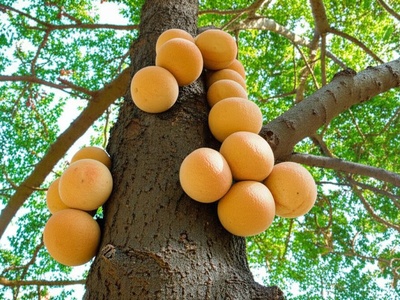
Tallow Tree
A large tree producing a round, fibrous fruit with a sweet, acidic pulp that tastes like a sweet-tart apple. The pulp is eaten fresh or made into drinks. The dense wood is used for construction.

Indian Jujube
A small to medium, thorny tree with drooping branches, producing a small, apple-like fruit. The fruit is highly nutritious and eaten fresh or dried. The tree is extremely drought-resistant.

Egyptian Mimosa
A thorny tree identified by its dark, fissured bark and distinctive long, constricted seed pods. It is a major source of tannin, fodder, and firewood, and its wood is very durable.

Red Acacia
A small, thorny tree recognizable by its rusty or greenish-yellow powdery bark. It produces a lower-grade gum arabic. The wood is a primary source of high-quality charcoal, and the bark is used in medicine.

Umbrella Thorn Acacia
A classic acacia with a distinctive flat-topped, umbrella-like crown. Its twisted pods are a crucial source of dry-season fodder for livestock. The tree is exceptionally drought-resistant and a keystone species in desert ecosystems.

African Ebony
A large, evergreen tree with a dense, dark green crown and a long, straight trunk. It produces a sweet, edible yellow fruit. The heartwood is a valuable dark, hard ebony, used for carving and construction.
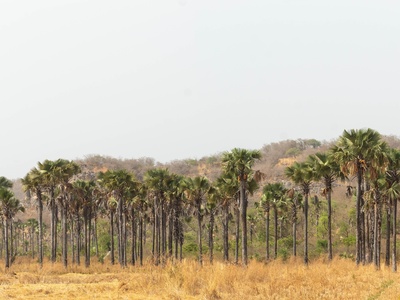
African Fan Palm
A distinctive palm that often branches, creating multiple crowns of fan-shaped leaves. It produces an edible, gingerbread-flavored fruit. The leaves are used for weaving mats, baskets, and thatching.

Senegal Date Palm
A clumping palm that forms dense thickets with slender, leaning trunks. It produces small, edible dates, though they are less fleshy than commercial dates. The leaves are used for making mats and baskets.

Oil Palm
The source of palm oil, this iconic palm has a stout trunk and a crown of large pinnate leaves. The reddish fruit yields two types of oil: palm oil from the flesh and palm kernel oil from the seed.
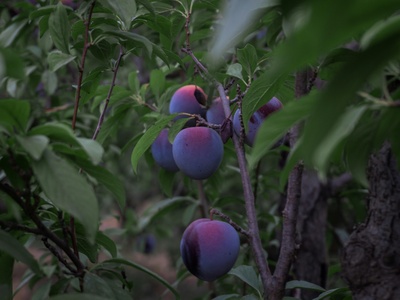
Black Plum
A medium-sized tree with a rounded crown and distinctive hand-shaped leaves. It produces a sweet, black, prune-like fruit that is eaten fresh or made into jam and wine. The leaves are also eaten as a vegetable.

Fever Berry
A small, aromatic tree or large shrub with striking silvery-white undersides to its leaves. The leaves and bark are widely used in traditional medicine, particularly for treating fevers, coughs, and respiratory ailments.

African Teak
A giant forest tree, also known as Iroko, yielding a highly valued, durable, and termite-resistant timber. It is often left standing in cleared farmland due to its cultural significance and is considered sacred by many communities.
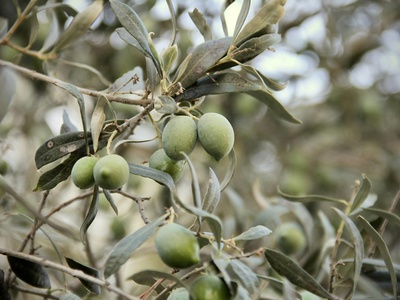
African Olive
A wild relative of the cultivated olive, this hardy, evergreen tree has a gnarled trunk and glossy grey-green leaves. It produces small, bitter, purple-black fruits. Its hard wood is used for fine carving.

Candlewood
A small, thorny tree with aromatic leaves and bark. The roots and bark have a pungent taste and are famously used as “chewing sticks” for dental hygiene. Various parts are used in traditional medicine.
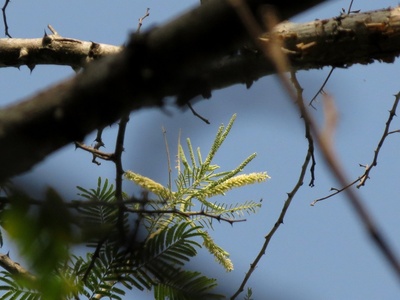
White Thorn
A low-growing, multi-stemmed acacia that often forms dense, impenetrable thickets. It is characterized by its large, woody, persistent pods that lie on the ground. It is an important soil stabilizer.
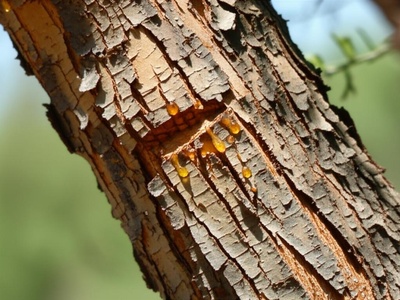
African Myrrh
A small, spiny tree with a peeling, papery bark. It exudes a fragrant, medicinal resin (myrrh) when the bark is cut. The resin is used as an incense and for treating wounds and sores.
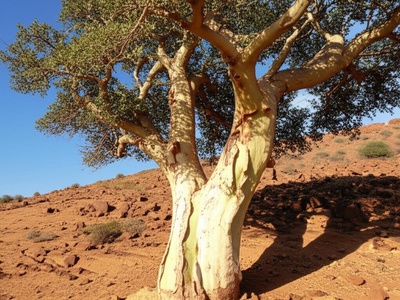
Frankincense Tree
A medium-sized tree with a pale, papery, peeling bark. It produces an aromatic resin (frankincense) used for incense and traditional medicine. The bark is also used to treat gastrointestinal issues.
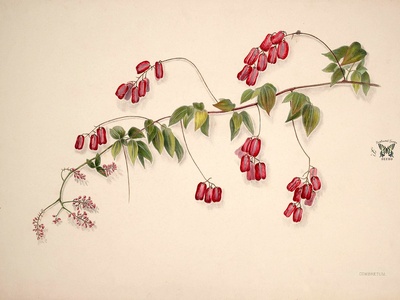
Bushwillow
A scrambling shrub or small tree, known locally as ‘kinkeliba’. Its leaves are famous for making a medicinal tea used as a tonic and to treat liver ailments and fevers. It is a very common savanna species.

Velvet Tamarind
A tall tree producing small, black, velvety pods. Inside is an orange-brown pulp with a sweet-sour, tamarind-like flavor that is very popular as a snack. The wood is hard and used for charcoal.
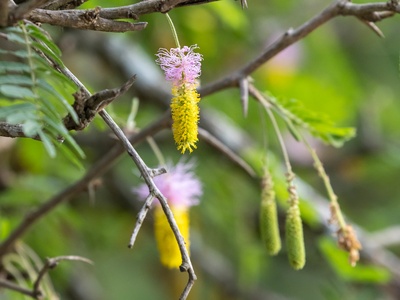
Sickle Bush
A spiny, often multi-stemmed shrub or small tree. Easily identified by its bicolored pink and yellow flowers and distinctive, tightly clustered, sickle-shaped pods. It can form dense thickets.

Quinine Tree
A small evergreen tree with leaves arranged in whorls. Its bark and roots contain alkaloids, including reserpine, used in modern medicine to treat high blood pressure. It is highly valued in traditional medicine.
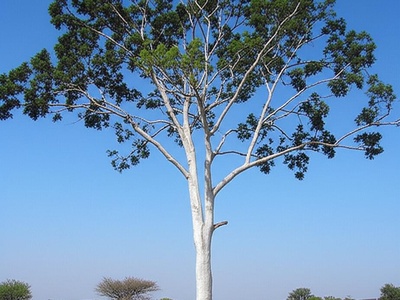
Anogeissus
A graceful tree with a straight trunk, light-colored bark, and drooping branches. Its timber is very hard and termite-resistant, used for construction and tool handles. The leaves yield a yellow dye.

Wild Mango
A deciduous tree with a spreading crown, not related to the true mango. It produces a large, yellow, mango-like fruit with a fibrous, sticky pulp that is edible and rich in vitamin C.

Grey-haired Bushwillow
A small, resilient savanna tree whose leaves become very sticky with resin during the dry season. It is a key source of firewood and charcoal, and its leaves are used in many traditional medicinal preparations.
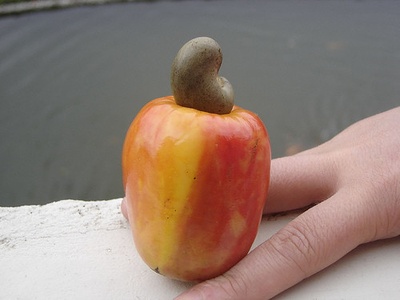
Cashew
Introduced from Brazil, this tree is now widely cultivated and naturalized. It produces the cashew nut, which grows from the bottom of a fleshy, pear-shaped “cashew apple.” It is a major cash crop.
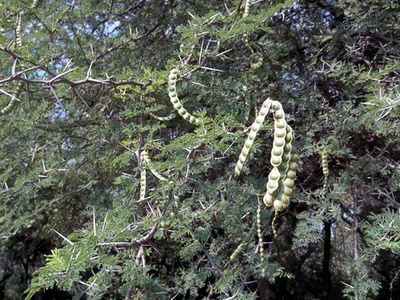
Scented-pod Acacia
A flat-topped acacia with hooked thorns and hairy, grey-green foliage. Its pods are sickle-shaped and covered in velvety hairs. The bark is rich in tannins, and it provides good firewood.

African Apple
A deciduous tree with a dense crown and peeling bark. It produces clusters of small, grape-like, edible fruits that have a sweet, acidic taste. The tree is also a source of a reddish-brown dye.

Smoky-barked Acacia
A multi-stemmed shrub or small tree with smooth, greyish bark and both hooked and straight thorns. It produces a good quality gum and is heavily browsed by camels and goats, providing important fodder.

Bitter Leaf
A small tree or shrub famous for its extremely bitter leaves. The leaves are used as a vegetable in soups and stews after being washed to reduce bitterness. They are also a potent traditional medicine for fevers and parasites.

Red Ironwood
A savanna tree with a gnarled trunk and long, narrow leaves clustered at the branch tips. It produces a non-drying oil from its seeds. The wood is extremely hard, heavy, and durable.
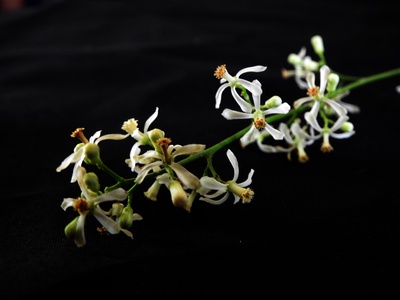
Neem
An introduced evergreen tree from Asia, now ubiquitous. It is prized for its medicinal properties, particularly as an insecticide and antimalarial. It’s a fast-growing shade tree tolerant of drought.
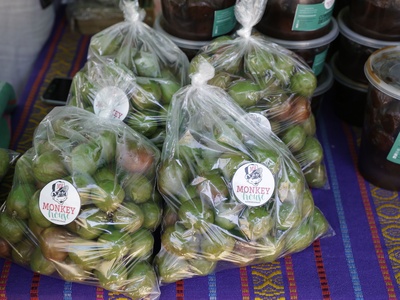
Jocote
A small, spreading tree native to the Americas. It produces a delicious, juicy fruit resembling a small plum, which is eaten fresh. The tree is deciduous and flowers on bare branches.
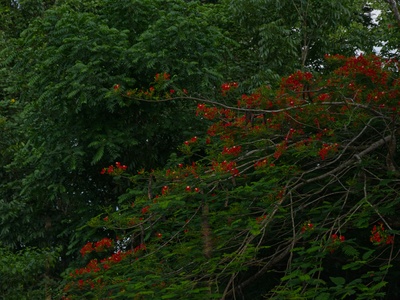
Flamboyant Tree
Native to Madagascar, this tree is famous for its stunning display of fiery red-orange flowers. It has a wide, umbrella-shaped crown and feathery leaves, providing excellent shade.
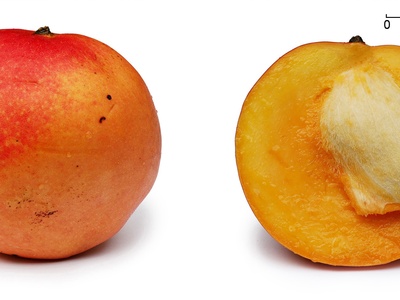
Mango
A large, evergreen tree from Asia, now a staple fruit tree in Senegal. It produces the popular mango fruit and provides dense shade. Many varieties are grown, ripening at different times.
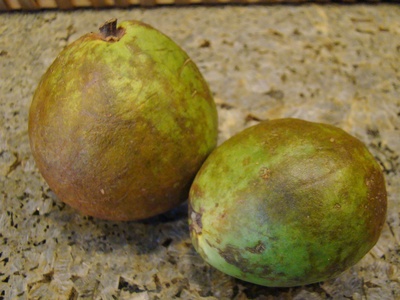
Guava
A small tree from the Americas, now common in Senegal. It produces the well-known guava fruit, which is aromatic and rich in vitamins. Its leaves are used to make a medicinal tea for digestive issues.
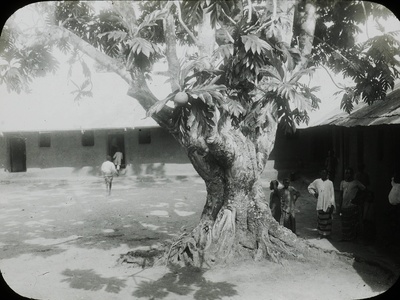
African Breadfruit
A large forest tree that produces a huge, round, warty fruit that can weigh over 10 kg. The numerous seeds inside are roasted, boiled, or ground into flour, forming a staple food in some areas.

Fig Tree
A common fig species that can start life as an epiphyte, eventually strangling its host tree. It has a dense, spreading crown and produces small figs. It is a very important keystone species for fruit-eating animals.
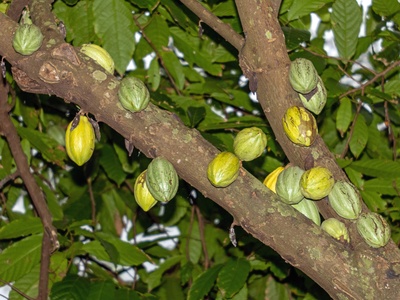
Sycomore Fig
A large, spreading fig tree with a distinctive yellowish bark. It produces clusters of edible figs directly on its trunk and main branches. The wood is light and was used in ancient Egypt for sarcophagi.
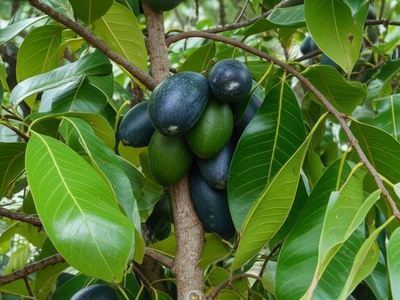
Jagua
A tree from tropical America, sometimes found in southern Senegal. It produces an edible fruit that yields a dark blue-black, long-lasting dye used for body painting and coloring fabrics.
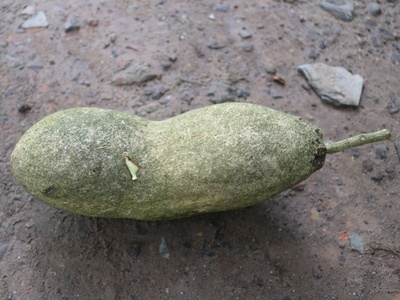
Sausage Tree
Named for its large, sausage-shaped fruits that hang from long stalks. While the fruit is generally not eaten by humans, it is used extensively in traditional medicine for skin ailments.

Soapberry
This tree produces small, fleshy fruits whose pulp contains saponins. When mixed with water, the pulp lathers and can be used as a natural soap for washing clothes and hair.
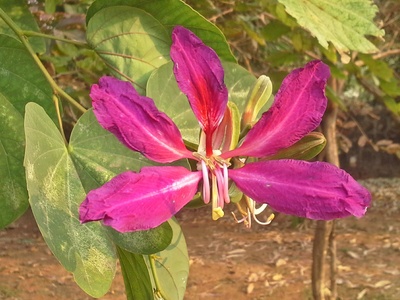
Camel’s Foot
A small, hardy tree with distinctive bi-lobed leaves that resemble a camel’s hoof print. Its pods and bark are rich in tannins, used for tanning leather. It is an important soil-improving species.

African Birch
A vigorous climbing shrub or small tree known for its spectacular crimson flowers that appear in dense panicles. It is more of a liana but can form a tree-like structure, adding a splash of color to the forest.
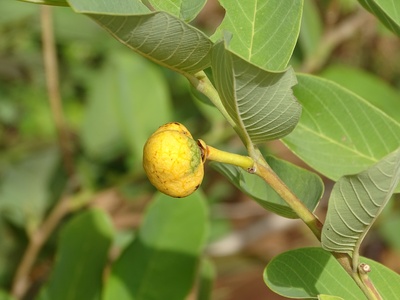
Wild Custard Apple
A small deciduous tree or shrub with bluish-green leaves and aromatic bark. It produces an edible, orange, fleshy fruit with a flavor similar to cultivated custard apples. The leaves and roots are used medicinally.
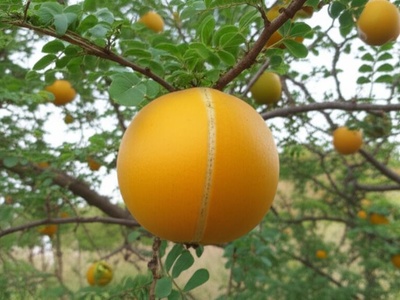
Monkey Orange
A small, spiny tree with a rounded crown. It bears a large, hard-shelled, yellow fruit containing a sweet-sour pulp and numerous seeds. The pulp is edible, but the seeds are toxic.

Bush Mango
A large forest tree valued for its edible, mango-like fruit and its seeds, known as ‘ogbono’ or ‘dika’ nuts. The seeds are ground and used as a powerful thickener for soups and stews.

Senegal Lilac
A small, graceful tree with slender branches, known for its beautiful, fragrant, lilac-colored flowers. The roots are highly poisonous but are a very important and powerful component in traditional medicine.
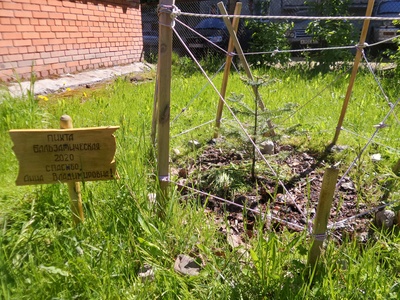
Balsam Tree
A large tree with a straight, clean bole. When the bark is cut, it exudes a fragrant oleo-resin called African copaiba balsam, which is used for incense and medicinal purposes. The wood is light and easy to work.

Bastard Mahogany
An attractive evergreen tree with a dense, dark green crown. It produces a valuable oil from its seeds, similar to shea butter, used for cooking and cosmetics. The wood resembles mahogany but is of lower quality.
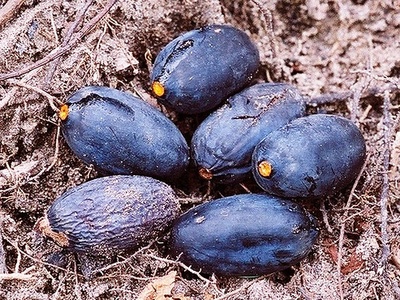
African Canarium
A large forest tree that produces a small, purple, olive-like fruit. The oily pulp is edible after being softened in warm water. The tree also yields an aromatic resin used as an incense.

Eucalyptus
An introduced Australian species, now common across Senegal. It is very fast-growing and drought-tolerant but can negatively impact biodiversity and water tables. It is a major source of firewood and poles.

Acacia sieberiana
A medium to large tree with a flat-topped, spreading crown, making it a classic savanna sight. It has rough, yellowish-brown bark. The pods provide fodder, and the gum is edible.
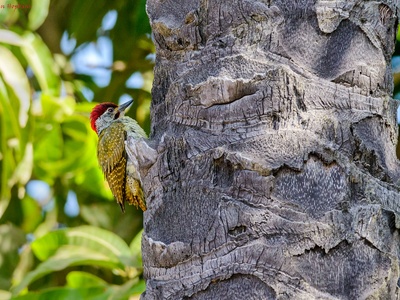
Rhun Palm
A palm tree with very long, pinnate leaves that can reach over 10 meters. It is the source of raffia fiber, used for weaving textiles, baskets, and constructing houses. The sap is also used to make palm wine.
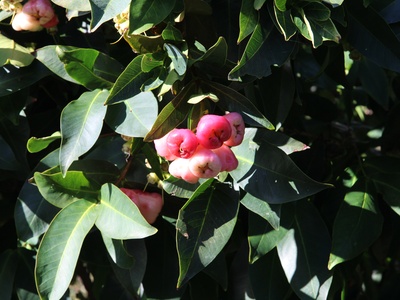
Water Berry
An evergreen tree with a dense crown and glossy leaves. It produces small, edible, purple-black fruits that are juicy but often astringent. The tree is an indicator of groundwater.
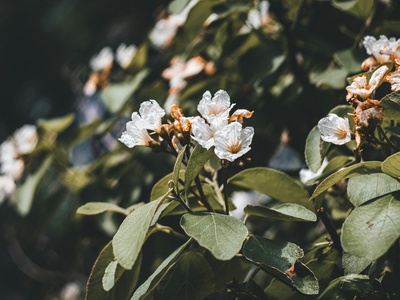
Cordia
A fast-growing, medium-sized tree with a spreading crown and large, rough leaves. It produces small, sweet, edible fruits. Its lightweight, durable wood is highly valued for furniture, beehives, and mortars.
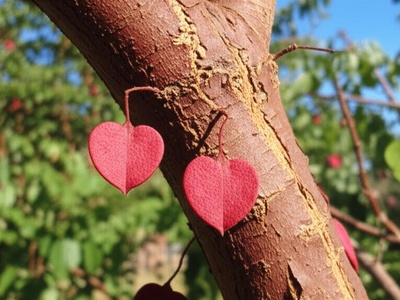
Corkwood
A small, gnarled tree with reddish, flaky bark. The most distinctive feature is its two-winged, heart-shaped, reddish fruit. The wood is hard and used for fuel, and the bark is used for red-brown dye.
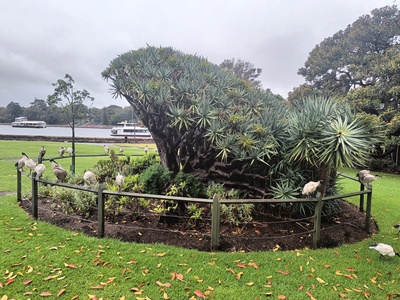
African Dragon’s Blood Tree
A tree-like monocot with a palm-like appearance, featuring a crown of long, sword-shaped leaves. When the stem is cut, it exudes a reddish resin, known as “dragon’s blood.”

Gmelina
A fast-growing, deciduous tree introduced from Asia for timber and pulpwood plantations. It has large, heart-shaped leaves and produces a fleshy, yellow fruit. It can become invasive in some habitats.
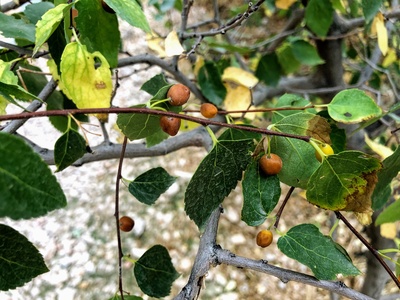
White Stinkwood
A deciduous tree with a smooth, pale grey bark and a dense, rounded crown. Its wood has an unpleasant smell when freshly cut. It produces small, sweet, berry-like fruits that attract birds.

Red Stinkwood
A rare evergreen tree in Senegal, valued for its medicinal bark, which is used to treat prostate disorders. Over-harvesting has made it an endangered species across its African range.

Terminalia
A savanna tree with large leaves clustered at the ends of the branches. It is highly fire-resistant due to its thick, corky bark. The roots and leaves are important in traditional medicine.
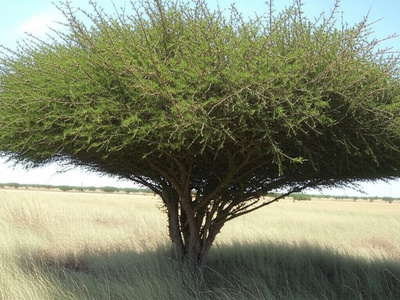
Cat’s Claw
A small, thorny, and much-branched tree. It produces a hard-shelled, gourd-like fruit that is used as a fish poison. The sharp spines make it a useful component of live fencing.
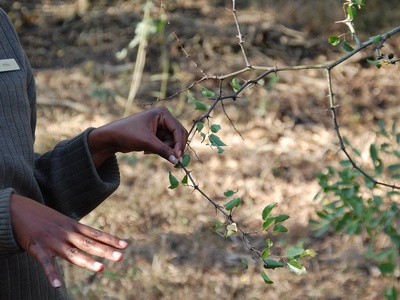
Buffalo Thorn
A small to medium-sized tree armed with pairs of thorns, one hooked and one straight. The reddish-brown, glossy fruits are edible but not highly palatable. The leaves are nutritious fodder for livestock.

Leadwood
A common savanna tree with soft, hairy, grey-green leaves and a dark, rough bark. Its wood is hard and termite-resistant, making it good for fence posts and high-quality charcoal. The leaves are used medicinally.

Strychnine Tree
An introduced tree native to Asia. It is the source of the highly poisonous alkaloids strychnine and brucine. Despite its toxicity, it has uses in traditional and modern medicine in minute doses.

Wild Pear
A small, multi-stemmed tree or large shrub that produces beautiful clusters of white to pink, paper-like flowers, often on bare branches. It is a fast-growing pioneer species, attractive to bees.

Raisin Bush
A small tree or shrub with rough, sandpapery leaves. It produces small, sweet, edible fruits that can be eaten fresh or used to flavor drinks. The fibrous bark is used to make rope.

False Mopane
A medium-sized, deciduous tree with characteristic “butterfly wing” paired leaflets. The seeds are covered by a bright red, fleshy aril, which is edible and nutritious. The wood is hard and durable.
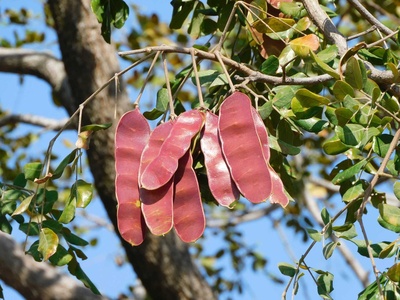
Poison-pod Albizia
A deciduous tree with a spreading, flat crown and large, feathery leaves. The large, flat, reddish-brown pods are poisonous to livestock, hence its name. The wood is used for light construction and carving.
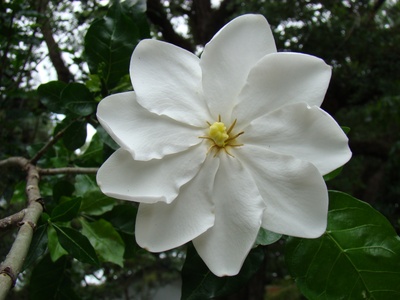
Wild Gardenia
A small, rigid tree with branches in whorls of three. It produces large, fragrant, white flowers that fade to yellow. The hard, woody fruit is used in traditional medicine and as a source of black dye.
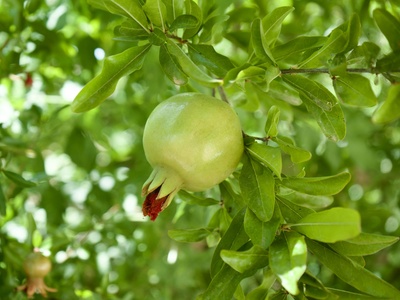
African Star Apple
A large forest tree that yields a sweet, edible fruit with a star-shaped pattern in the cross-section. The pulp is often eaten fresh. The tree is valued for both its fruit and timber.
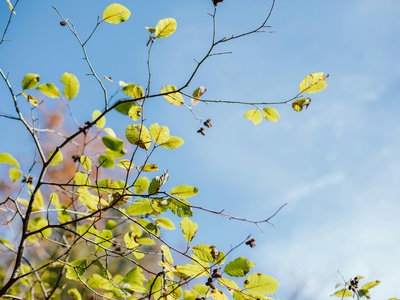
Leafflower Tree
A fast-growing pioneer tree with a light crown. It’s often one of the first trees to colonize cleared areas. The wood is used for general-purpose construction, and the bark has medicinal uses.
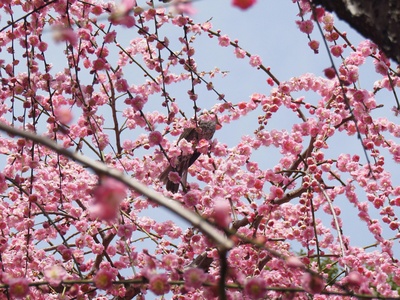
Bird Plum
A tree with a dense crown that produces a sweet, date-like fruit that is very popular with both people and birds. The fruit can be eaten fresh or used to make a type of porridge or alcoholic beverage.

Fishtail Acacia
A fast-growing acacia with a whitish or pale-yellow trunk and numerous hooked thorns. It gets its name from its flat pods, which resemble a fish’s tail. The wood is a good general-purpose timber.
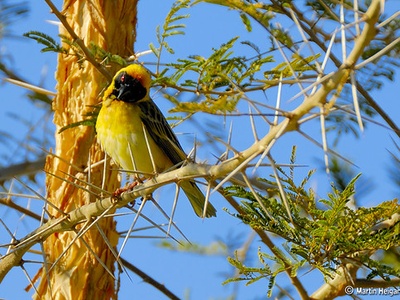
Paperbark Thorn
A medium-sized acacia with a rough, yellowish, corky bark that can be peeled off in papery strips. It has a spreading crown and provides good shade. The flowers are an important source of bee forage.
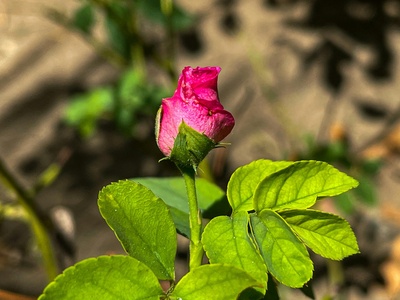
African Dog Rose
A tall, slender, evergreen tree. Its dried, pungent, aromatic fruits are known as “Grains of Selim” and are used as a peppery spice in West African cuisine. The wood is light but flexible.

Jumping Seed Tree
A deciduous tree that produces a three-lobed fruit capsule. As the capsule dries, it can split open with an audible crack, flinging the seeds away. The latex is poisonous and used as a fish poison.
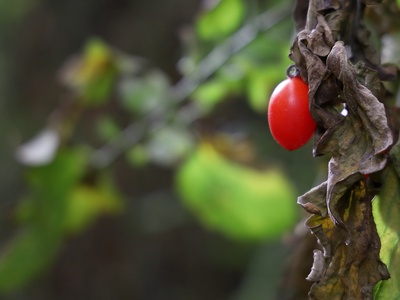
Bush Cherry
A small evergreen tree with a rounded crown and leathery leaves. It produces distinctive, finger-like, constricted fruits. The leaves are used as a vegetable and fodder, and the roots are used in medicine.

Crown Berry
A small, semi-deciduous tree with a rough, dark, corky bark. The bark is a well-known traditional remedy for fevers, hence the specific name ‘febrifuga’. It produces small, hard, woody capsules.
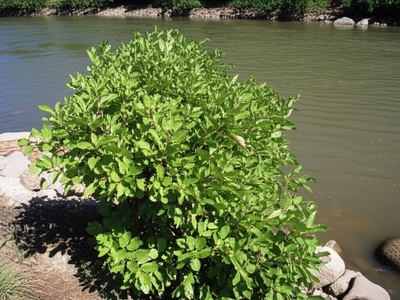
Fara
A shrub or small tree that grows exclusively on riverbanks. Its leaves are very rough, like sandpaper, and are used for scouring pots and pans. The figs are eaten by fish and other aquatic animals.
